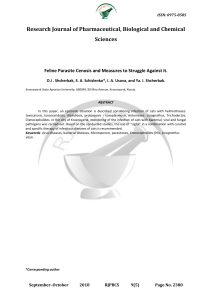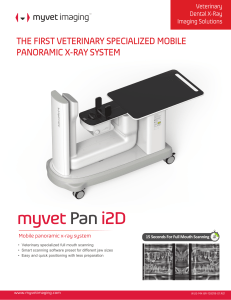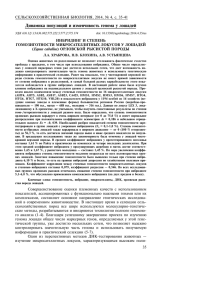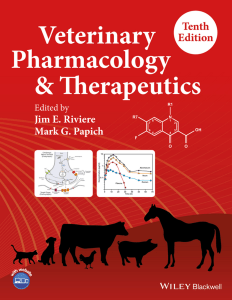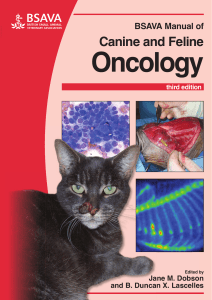Textbook 2008 (Excerpt)
реклама
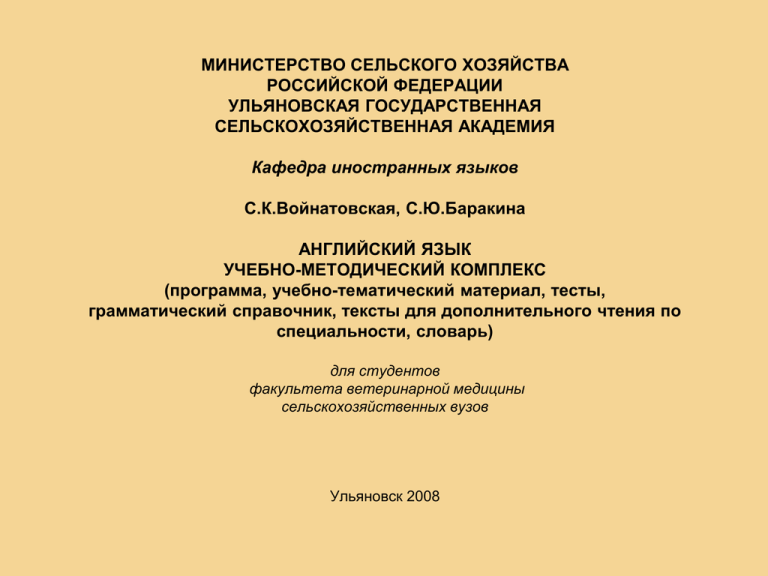
МИНИСТЕРСТВО СЕЛЬСКОГО ХОЗЯЙСТВА РОССИЙСКОЙ ФЕДЕРАЦИИ УЛЬЯНОВСКАЯ ГОСУДАРСТВЕННАЯ СЕЛЬСКОХОЗЯЙСТВЕННАЯ АКАДЕМИЯ Кафедра иностранных языков С.К.Войнатовская, С.Ю.Баракина АНГЛИЙСКИЙ ЯЗЫК УЧЕБНО-МЕТОДИЧЕСКИЙ КОМПЛЕКС (программа, учебно-тематический материал, тесты, грамматический справочник, тексты для дополнительного чтения по специальности, словарь) для студентов факультета ветеринарной медицины сельскохозяйственных вузов Ульяновск 2008 CONTENTS Предисловие …………………………………………………………. 3 Рабочая программа……………..………………………………….. 4 Chapter I. The Tasks of Veterinary Service. The Work of Veterinarians…………………………………………………..12 Unit I. Veterinary service…………………………………………… 12 Unit II. A veterinary school in the USA……………………………… 16 Unit III. Veterinary technologists and technicians…………………. 20 Unit IV. Animal laws………………………………………………….. 25 Unit V. Progress check………………………………………………. 29 Chapter II. Mammals……………………………………………33 Unit I. Livestock……………………………………………………….. 33 Unit II. Cow…………………………………………………………….. 39 Unit III. Cow…………………………………………………………… 45 Unit IV. Horse…………………………………………………………. 50 Unit V. Pig……………………………………………………………… 56 Unit VI. Sheep…………………………………………………………. 60 Unit VII. Dog and cat.………………………………………………… 63 Unit VIII. Progress check…………………………………………….. 67 Chapter III. Animal Diseases…………………………………69 Unit I. Classification of animal diseases……………………………. 69 Unit II. Nutritional diseases…………………………………………...73 Unit III. Non-infectious diseases. …………………………………….76 Unit IV. Infectious diseases………………………………………….. 80 Unit V. Contagious diseases…………………………………………84 Unit VI. Progress Check……………………………………………… 87 Unit VII. Foot-and-mouth diseases………………………………….. 89 Unit VIII. Anthrax……………………………………………………….94 Unit IX. Eastern equine encephalomyelitis………………………….97 Unit X. Brucellosis…………………………………………………….. 101 Unit XI. Swine dysentery………………………………………………104 Unit XII. Surgical operation………………………………………… 108 Unit XIII. Progress check..…………………………………………… 110 Grammar Reference…………………………………………….114 Supplementary reading………………………………………..133 Appendix I……………………………………………………………177 Vocabulary…………………………………………………………..179 Unit IV. Horse Grammar: Reported Speech Text: Text A Health and the horse I. Read the text and then give it a title. The horse (Equus caballus) is a large ungulate mammal. For centuries horses have been one of the most economically important domesticated animals, especially used for farm work and for transportation. The history of the horse is prominent in religion, mythology, art, transportation, agriculture and warfare. Most horses perform work such as carrying humans or are harnessed to pull objects such as carts or plows. Hundreds of distinct horse breeds have been developed, allowing horses to be specialized for certain tasks; lighter horses for racing or riding, heavier horses for farming and other tasks requiring pulling power. Some horses, such as the miniature horse, can be kept as pets. In some societies, horses are a source of food, both meat and milk; in others it is taboo to consume these products. In industrialized countries, horses are predominantly kept for leisure and sporting pursuits, while in other parts of the world they are still used as working animals. Horses and humans have lived and worked together for thousands of years. Depending on breed, management and environment, the domestic horse today has a life of 25 to 30 years. The oldest verifiable record was "Old Billy," a horse that lived in the 19th century to the age of 62. In modern times, Sugar Puff, who had been listed in the Guinness Book of World Records as the world's oldest pony, died at age 56. Horse breeds are groups of horses with distinctive characteristics, such as conformation, color, performance, intelligence or disposition that are transmitted consistently to their offspring. These inherited traits are usually the result of a combination of natural crosses and artificial selection methods aimed at developing horses for specific tasks. Certain breeds are known for certain talents, for example, Standardbreds are known for their speed in harness. Some breeds have been developed through centuries of crossings with other breeds, while others such as Tennessee Walking Horses and Morgans developed from a single sire with a tremendous influence. There are more than 300 horse breeds in the world today. Active Words to harness [´ha:nis] - использовать distinct [di´stiŋkt] - отдельный, особый, отличный racing [´reisiŋ] - состязание в беге, скачки riding [´raidiŋ] - верховая езда leisure [´leʒə] - досуг, свободное время pursuit [pə´sju:t] - преследование, погоня conformation [kɒnfɔ:´meiʃn] - форма, структура performance [pə´fɔ:məns] - исполнение, представление disposition [dispə´ziʃn] - характер, нрав to transmit [trænz´mit] - передавать, отправлять consistent [kən´sistənt] - последовательный, стойкий offspring [´ɒfspriŋ] - потомок to inherit - [in´herit] - унаследовать trait [trei] - характерная черта, особенность artificial [a:ti´fiʃl] - искусственный harness [´ha:nis] - упряжь, сбруя sire [´saiə] - производитель (о жеребце) tremendous [tri´mendəs] - огромный, громадный; страшный influence [´infuəns] - влияние, действие II. Translate the following words and phrases from Russian into English: Копытное животное, телега, скачки, в течение веков, война, перевозка людей, быть предназначенным для определенных целей, плуг, унаследовать, источник еды, в зависимости от породы, отличительные характеристики, верховая езда, скрещивание с другими породами, потомок, производитель. III. Complete the following sentences. Choose the ending according to the text: Horse breeds are groups of horses with distinctive characteristics Most horses perform work such as 3. Depending on breed, management and environment, 4. Certain breeds are known for 5. Hundreds of distinct horse breeds have been developed а) certain talents, for example, for their speed in harness. b) the domestic horse today has a life of 25 to 30 years. c) to be specialized for certain tasks. d) such as conformation, color, performance, intelligence that are transmitted to their offspring. e) carrying humans or are harnessed to pull objects such as carts or plows. IV. Use the following questions in your group to talk about horses: Give the characteristic of the horse. What work have most horses performed for centuries? Horses are specialized for certain tasks. What are they? How long do horses live? What are horse breeds? Certain breeds are known for certain talents, aren’t they? V. Revise the rule in the Grammar Reference § 10. Report the sentences according to the model. Model 1. She says, “He works in the veterinary clinic.” She says that he works in the veterinary clinic. Model 2. She said, “He worked in the veterinary clinic last year.” She said that he had worked in the veterinary clinic the year before. 1. She said, “The horse is a large ungulate mammal.” 2. He says, “Horse has been one of the most economically important domesticated animals”. 3. I noted, “Most horses perform work such as carrying humans or pull carts or plows”. 4. They answered, “Some miniature horse can be kept as pets.” 5. Jane says, “Horses and humans have lived and worked together for thousands of years.” 6. Tom remarked, “The domestic horse today has a life of 25 to 30 years.” 7. Mike told, “Some breeds have been developed through centuries of crossings with other breeds.” 8. His friend shouted, “There are more than 300 horse breeds in the world today!” VI. Having read this text what can you say about horses? VII. Look at the picture and match the organs of the horse with their names given below. Use the dictionary. 1 - губы, 2 - ноздри, 3 глаз, 5 - уши, 6 гребень шеи, 7 - грива, 8 - холка, 9 - спина, 10 поясница – 11 крестец, 12 - круп, 13 репица хвоста, 15 голень, 16 - пятка, 18 колено, 19 - плюсна, 20 - копыто, 21 – путо (бабка), 23 - пясть, 24 запястье, 25 предплечье, 26 - плечо, 28 - живот ___________________________________________________ ears, stomach, heel, lips, wrist , eye, back, forearm, crest, small of the back, sacrum, nostrils, croup, pastern, dock, gaskin, knee, hoof, metacarpus, mane, withers, shoulder, metatarsus VIII. Choose the appropriate definition. 1. The eye is a) the foot of the horse. 2. The muzzle on the horse’s face make up b) the connection between the hoof and the fetlock. 3. Mane is c) the sense organ that detects sounds. 4. Hoof is d) the high point on the back of an animal, on the ridge between its shoulder blades. 5. Ears are e) the point where the tail connects to the rear of the horse. 6. Pastern is f) the line of the hair along the spine of the neck, striating behind the ears and ending just above the wither. 7. Dock is g) the organ that detect light. 8. The withers is h) the chin, mouth and nostrils. IX. Read the text and fill in the table that follows it. HEALTH AND THE HORSE Horses like any animal they can fall ill or be injured. A healthy pony or horse is alert, bright eyed and takes an interest in all that goes on around it. The base of the ears should be warm to the touch. Signs of illness vary, but there are some general symptoms. A field-kept pony which stays for a long time in one place, a horse which goes off its food, a willing horse which suddenly becomes "nappy" — all these sings are indications that something is wrong. Other symptoms include: discharge from the eyes or nostrils;; restlessness; general lack of interest; sweating; kicking or biting at the flank; lameness; diarrhea; apparent difficulty in breathing; coughing. Lameness is the commonest form of disability in the horse. Treating most forms of it is usually best left to an expert. Wounds and injuries are another common problem. First bring the bleeding under control applying a pressure bandage. Clip the hair from the skin around the wound and clean it thoroughly. Then coat with an anti-biotic powder and dress. Like humans, horses can easily catch skin diseases, particularly in unhygienic conditions. Skin diseases include lice, ringworm, sweet itch, mud fever, pustular dermatitis, and nettle rash. Teeth and stomach cab both give the horse problems. Both demand serious attention. Signs of healthy horse Signs of an ill horse Most common problems Treating wounds Unit VIII. Progress Check I.Read the text and find the sentences containing Participle I, Participle II, the Gerund, the Infinitive and state their function. Points - 9 Animal husbandry is an important component of modern agriculture. Animal husbandry is the agricultural practice of breeding and raising livestock. Livestock is the term used to refer to a domesticated animal reared in an agricultural setting to produce such as food or fibre, or for animal’s labour. The science of animal husbandry is taught in many universities and colleges around the world. Students of animal science may pursue degrees in veterinary medicine following graduation, or go on to pursue master's degrees or doctorates in disciplines such as genetics and breeding, or reproductive physiology. Graduates of these programs may be found working in the veterinary and human pharmaceutical industries, the livestock and pet supply and feed industries, or in academia. The mission is to provide with high quality services and support the relationship between people and their pets. One of our key roles is to implement government policies aimed at preventing or managing outbreak of serious animal diseases and in doing support the farming industry, protect the welfare of farmed animal and safeguard public health from animal borne disease. II. Can you translate these words? Choose the appropriate translation. Points - 13 1. liver a) сычуг 2. lung b)тонкая кишка 3. omasum c) ободочная кишка 4. abomasum d) желчный пузырь 5. gallbladder e) поджелудочная железа 6. kidney f) прямая кишка 7. small intestines g) печень 8. colon h) пищевод 9. tissue i) ткань 10. rectum j) легкие 11. esophagus k) почка 12. duodenum l) книжка 13. pancreas m) двенадцатиперстная кишка III. Match the organ in A with its functions in B. A. a) the liver; b) the kidneys; c) the abomasum; d) the intestine; e) the heart; f) the gall bladder; g) the lungs B. 1. A vital organ which enables the body to obtain oxygen from the air we breathe, and to eliminate carbon dioxide. 2. Its main functions are to regulate the amount of water and salt within the body, maintain the proper acid-base balance in the body, and to eliminate waste products from the blood. 3. It is the major part of the digestive system, extending from the duodenum to the anus. 4. It is a hollow, muscular organ where the process of digesting swallowed food begins. 5. It is a small sac which sits just beneath the liver and its only role is to concentrate gall and then release it when food is passing through the small intestine. 6. It is a powerful pump that beats continuously during life to circulate the blood throughout the body. 7. It is the largest and one of the most vital organs which receives a dual blood supply. Points – 7 IV. Read the text B and say which part of the text is about: a) cats and dogs are omnivorous; b) correct feeding of domestic animals; c) the influence of incorrect feeding on a growing kittens or puppies PET NUTRITION Feeding is an important factor in cat’s and dog’s life. A lot of research has bee done to determine the nutrient needs of dogs and cats. (1) Incorrect feeding of a growing little one affects body weight, height and constitution of an animal. If the feeding is incorrect, various serious diseases can develop by our pets. (2) Clever owner organizes feeding of domestic animals correctly, regulates the amount of food in accordance with their physiological needs. Feeding must be full (that is, should take into account the quality of nutrition), well-balanced (that is, should consider the interaction of certain substances in food and in the organism) and ration (should consider correct consumption of forage souses when scheduling a diet). (3) Most pet owners today feed their pets on commercial foods which are well-balanced. (4) In general both cats and dogs are omnivorous. They can eat meat, fish, milk, vegetable and grassy food. From time to time they eat grass or houseplants. In this way they get minerals and vitamins. Points - 3 MARK YOUR SCORE You can get 31 points. 29- 31 points – well done 26- 28 points – good 22- 25 points – you can do better 21 points or less – revise and try again 1. Read the following words paying attention to the pronunciation: progress, technology, material, industry, to produce, mechanization, product, productivity, prophylaxes, organization, veterinary, sanitation, hygiene, to select 2. Read the text and find out the meaning of the following words. tissue, digestive, surgery, esophagus, small intestine, secretion, large intestine, pancreas, the rumen, gallbladder, nutrient, reticulum, omasum, abomasum, feedstuff Text A. The cow's digestive tract The cow's digestive tract consists of the mouth, esophagus, a complex fourcompartment stomach, small intestine and large intestine (figure 1). The stomach includes the rumen, reticulum, omasum, and abomasum. The rumen. The rumen (on the left side of the animal) is the largest of four compartments and is divided into several sacs. It depends on the size of the cow. Because of its size, the rumen acts as storage. A microbial population in the rumen digests or ferments feed eaten by the animal. Cattle sometimes consume heavy feed and metal objects which are deposited in the reticulum, the smallest compartment, and this is where hardware disease occurs. If not prevented by a magnet or corrected by surgery, infection may occur and the animal may die. 3. Scan through the text once again. 4. Make the sentences as true (T) or false (F). 1. The cat is a small carnivorous species of crepuscular mammal. 2. The cat is valued by humans for its companionship and its ability to hunt vermin, snakes and scorpions. 3. Cats have lowly advanced hearing, eyesight, taste, and touch receptors, making the cat extremely sensitive among mammals. 4. Cats' night vision is inferior to humans although their vision in daylight is superior. 5. Humans and cats have a different range of hearing on the low end of the scale. 6. A domestic cat's sense of smell is about fourteen times as strong as a human's. 7. Cats use a variety of vocalizations and types of body language for communication, including mewing, purring, hissing, growling. 5. Translate the sentences into Russian. 1. When selecting a commercial pet food it is important to read the label very carefully. 2. There is a whole group of bacterial diseases affecting the skin. 3. Skeletal problems are seen in cats fed diets composed primary of liver. 4. Maize is an excellent food for animas if given in combination with other food. 5. In developing countries animal diseases are tolerated in animal husbandry. 6. The sounds made by the cats have various meaning. 7. Livestock is the term used to refer to a domesticated animal intentionally reared in agriculture. 8. Mammalian livestock can be used as a source of milk. 6. Make up sentences. 1) of, species, a small, the cat, is, carnivorous, mammal, crepuscular. 2) can, the cat, food , hunt, species, 1,000 , for. 3) cats, mechanisms, simple, are able to, manipulate. 4) popular, may, in the world, pet, cats , the most, be . 5) cats, have, hearing, advanced, highly, eyesight, touch receptors, taste, and. 6) the world, cats, the most, in, be, pet, may. 7. Complete the following sentences. Choose the ending according to the text: 1. The cow's digestive tract consists of 2. The stomach includes 3. The rumen is 4. The rumen is divided into 5. The reticulum is 6. The globe-shaped structure of the omasum contains 7. The small intestine receives 8. Most of the digestive process is completed in. 9. Through large intestine pass a) the rumen, reticulum, omasum, and abomasum. b) of the mouth, esophagus, a complex four-compartment stomach, small intestine and large intestine. c) the small intestine. d) leaves of tissue. e) the largest of four compartments cow's stomach. f) the smallest compartment of cow's stomach. g) the secretions of the pancreas and the gallbladder. h) undigested feedstuffs. i) several sacs. 8. I. Translate the following words and phrases from English into Russian: To practice under the supervision of a licensed veterinarian, veterinary care, the skills, to injure, sign of pain, despite, to take blood samples, routine laboratory and clinical procedures, to record information on an animal’s diet and weight, to conduct clinical work, education and training, experienced veterinary technicians, to care for companion animals, employer. II. Give the English equivalents for following: пищеварительный тракт, желчный пузырь, толстая кишка, книжка, ткань, питательное вещество, желудок, сычуг, тонкая кишка, сетка, всасывать воду и другие вещества, пищевод, рубец, поджелудочная железа, состоять из, самый большой из четырех компонентов, по размеру, может попасть инфекция, переваривать, непереваренный. III. Match the English words with their translation. 1. as a sequence of a) гнойная полость 2. in contradiction b) воспаление перикарда 3. condition c) различные 4. ruminant d) в результате 5. pus pocket e) в противоположность 6. to penetrate f) условие 7. pericardities g) жвачное животное 8. various h) проникать внутрь 9. reticulum j) встречаемость 10. occurrence k) сетка 9. Choose the appropriate definition. disease symptoms 1) tetanus a) a bloody diarrhea 2) ringworm b) los of condition, weakness, rough hair coat and diarrhea 3) mastitis c) stiffness 4) swine dysentery e) blisters, containing a straw-colored fluid, appearing in he mouth on the muzzle, udder, teats. 5) tuberculosis f) clotted and watery milk, fever, pain, swelling and change in the shape of the udder 6) foot-and-mouth disease g) if the disease is in the lung there may be a cough; in the intestines ,chronic diarrhea; in the joints, testicles. 10. II. Complete the sentences with the words in its appropriate form. 1. … is an important component of modern agriculture 2.… is the term used to refer to a domesticated animal intentionally reared in an agricultural setting to produce such as food or fibre. 3. Mammalian livestock … , which can be processed into other dairy products such as yogurt, cheese, butter. 4. The economic value of livestock is … 5. Sheep and goats produce … . 6. Cows, deer, and sheep can make … . 7. … can be spread on fields to increase crop yields. 8. Horses, donkey, and yaks are still used … in many places of the world, including ploughing fields, transporting goods, and military functions. 9. The grazing of livestock is sometimes used as a way to control … . 10. During the history of animal husbandry … have arisen in an attempt to increase carcass utilization and reduce waste. animal husbandry; manure; can be used as a source of milk; for different purposes; livestock; huge; many secondary products; wool and mohair; leather; weeds and undergrowth III. Complete the sentences. 1. Sheep (были приручены) for agricultural purposes. 2. Sheep is primarily valued for their (шерсть) and (мясо). 3. They are also occasionally raised for (шкуры), as (молочное животное) or as model organisms for (науки). 4. As livestock, sheep are most-often associated with (пастушеским), (сельским) imagery. 5. Domestic sheep are relatively small (жвачные животные), typically with (рогами). 11. Translate the sentences. 1. Инфекционные болезни отличаются от заразных тем, что вторые передаются путем контакта. 2. Дизентерия свиней - одно из самых серьезных заболеваний. 3. Главный симптом болезни появляется через неделю или две. 4. Самый лучший метод предупреждения болезни – не помещать заболевшую свинью в стадо. 5. Больных свиней держат на карантине три недели. 6. В ранней стадии болезни рекомендуют никотиновую кислоту, которая легко усваивается. 12. Answer the questions: 1. What contagious or communicable diseases do you know? 2. What are the symptoms of tuberculosis in animals? 3. What is the cause of tuberculosis? 4. During the period of treatment the ailing patient is a source of infection, isn’t it? 5. Is tuberculosis a chronic disease of man or animals? 6. What method is used for the diagnosis of tuberculosis? 7. What does this method consist in? 13. Read the text B and give it a title. Write down five questions to this text. Text B Brucellosis of cattle may be controlled in several ways, the method used depending on herd conditions and the severity and extent of the disease in the herd. Four methods of control have been used successfully: test and slaughter, calfhood vaccination, sanitary control or herd management, and test and segregation. Treatment and prevention. Antibiotics like tetracyclins, rifampicin and the aminoglicosides streptomycin and gentamicin are effective against Brucella bacteria. However, the use of more than one antibiotic is needed for several weeks. 14. Prove that Britain has been one of the leading countries in the field of animal rights. 15. Make the plan to this text and according to your plan retell the text. 16. Read the text and give a summary of it. The domestic dog has been one of the most widely kept working and companion animals in human history, as well as being a food source in some cultures. There are estimated to be 400 million dogs in the world. The dog has developed into hundreds of varied breeds. Height measured to the withers ranges from a few inches in the Chihuahua to a few feet in the Irish Wolfhound; color varies from white through grays (usually called blue) to black, and browns from light (tan) to dark ("red" or "chocolate") in a wide variation of patterns; and, coats can be very short to many centimeters long, from coarse hair to straight or curly, or smooth. Modern dog breeds show more variation in size, appearance, and behavior than any other domestic animal. Dogs are predators and scavengers, possessing sharp teeth and strong jaws for attacking, holding, and tearing their food. Like many other predatory mammals, the dog has powerful muscles, fused wristbones, a cardiovascular system that supports both sprinting and endurance, and teeth for catching and tearing. A dog can identify a sound's location much faster than a human can, as well as hear sounds up to four times the distance that humans are able to.
